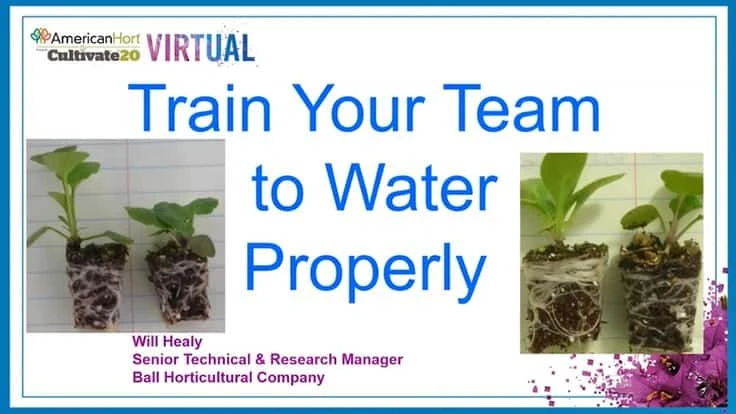
“Training your team to water properly is always a challenge in most organizations,” said Will Healy, who has been Ball Horticultural’s senior technical and research manager for 28 years. “The issue is, it is intuitively easy to water for some people, and unbelievably harder for others.”
Healy also said that difficulties with watering are equally attributed to training, or the lack thereof. Because there is a continuous stream of new employees and learners, Healy said water training often gets left behind. He also said that most companies don’t know how to train, and even when they do, growers who have nothing to do overwater plants to occupy their time. These combined result in poor watering habits, which Healy aims to resolve.
“What we want to do is make sure that we’re using the right watering technique so we don’t end up with plants that are too tall, are too short and with roots that aren’t in the right place in the pot. Correct watering techniques will end up with a cohesive, high-quality product,” he said.
To do that, it’s important to train growers on the best way to water.
The technique
Firstly, Healy said it’s important to understand that a grower’s job is not to “water,” but to “dry to the correct moisture.”
“When you’re training, you shouldn’t be thinking about how to water, you need to be thinking about, ‘How do I train people to anticipate when those plants will dry up?’ It sounds complicated, but it is not because it is predictive based on the environment and how much you water.”
One way to properly execute this, Healy said, is by pencil watering — planning what to do the next day.
According to Healy, “many growers suffer from PWS — paranoid watering syndrome,” which Healy jokingly said is the fear of plants wilting. “It’s a very serious disease in our industry.”
Many growers fear that if they do not water, the plants will die, which Healy attributes to a “faulty premise” in common training methods that says growers need to always water. This results in root rots, stretched plants, diseases, insect problems and more.
How so?
“Fish grow in water; roots grow in air. Our goal is to get as much air into that soil as we can,” he said. Healy used the term “soil matrix” to describe the mixture of peat moss, perlite and more in the soil, all of which have air spaces. As growers water, the air spaces are flooded. To get the air back in, Healy said the water must be removed.
To help train growers in this department, Healy developed a water knowledge pyramid which includes the following: language of watering, when to water, how much to water, where to water and climate.
- Language of watering (Level 1-Level 5) “Everyone has to speak the same language so they can communicate. You need to have a shared language, a shared communication of what’s going on.” The language of watering can be qualitative, which is opinion based and visually measured; or it can be quantitative, which is data based and measured through water weight.
- When to water When the weight of the pot is less than desired, it’s time to water. When the weight of the pot is more than desired, it’s time to drain.
- How much to water It’s important to water plants based on the level of moisture that matches the desired weight.
- Where to water Make sure the water is sprayed or poured where the roots are preferred, since they will follow the water.
- Plant demand As plants grow, the water demand increases because they grow larger and stretch. However, at some point, the water intake levels out, and the water demand decreases.
- Climate It’s important to understand what helps drive the moisture levels environmentally.
The pros of watering by weight
According to Healy, there are multiple cons of watering by weight. Since it’s data driven, it’s a better management tool, it allows for better plotting, it results in less stretched plants, it calculates daytime and nighttime losses and it’s a good way of recording weight.
In order to water successfully, Healy advised growers to draw the roots to the bottom of the container by saturating the plants to a level 4. Then drying to a level 2 to force the roots to go down.
“Train your watering pattern to a 4-2 — water to a 4 then dry to a 2 — to receive uniform bottoms of the cell,” he said.
These tips can be applied grower wide, which Healy hopes will happen to improve the industry’s watering processes and plants as a whole.
Latest from Greenhouse Management
- Anthura acquires Bromelia assets from Corn. Bak in Netherlands
- Top 10 stories for National Poinsettia Day
- Langendoen Mechanical hosts open house to showcase new greenhouse build
- Conor Foy joins EHR's national sales team
- Pantone announces its 2026 Color of the Year
- Syngenta granted federal registration for Trefinti nematicide/fungicide in ornamental market
- A legacy of influence
- HILA 2025 video highlights: John Gaydos of Proven Winners





